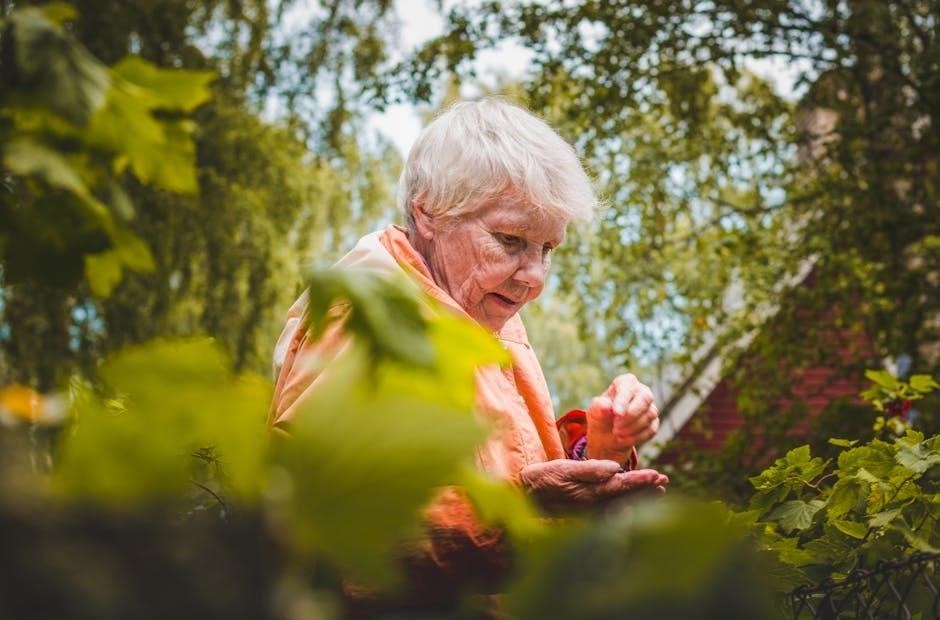The story revolves around an eccentric old lady who swallowed leaves, initiating a humorous chain of events. Written by Lucille Colandro, it blends fall themes with whimsical humor, making it a beloved educational resource. The narrative’s repetitive structure and seasonal elements engage young readers, while the PDF version offers accompanying activities for interactive learning.
1.1 Overview of the Narrative
There Was an Old Lady Who Swallowed Some Leaves by Lucille Colandro is a charming and engaging children’s book. It tells the story of an eccentric old lady who, in a surprising twist, swallows fallen leaves. This peculiar act sets off a series of humorous and unexpected events, as each swallowed item leads to a new, often comical consequence. The narrative follows a repetitive pattern, making it predictable and enjoyable for young readers. The story is filled with autumn-themed elements, such as leaves, hay, and pumpkins, tying it closely to the fall season. The old lady’s quirky actions and the story’s rhythmic flow make it both entertaining and educational, fostering language development and creative thinking in children. The book is also accompanied by free printable worksheets and activities, enhancing its value as a teaching tool.
1.2 The Old Lady’s Unusual Actions

The old lady’s actions are at the heart of the story, captivating readers with her peculiar behavior. She begins by swallowing leaves, an act that sparks curiosity and humor. As the narrative progresses, her consumption of fall-themed items like hay, pumpkins, and even a scarecrow adds layers of absurdity. Each swallowed object leads to a new, often comical consequence, keeping young readers engaged. Her motivations, though unclear, drive the story’s momentum. The repetitive nature of her actions creates a sense of predictability, making the story accessible and memorable for children. These unusual actions not only entertain but also serve as a creative way to explore themes of cause and effect, making the old lady a memorable and intriguing character.
Book Structure and Content
The book follows a repetitive storytelling pattern, with the old lady swallowing fall-themed items like leaves, hay, and pumpkins, each leading to humorous and logical consequences.
2.1 Repetitive Pattern in Storytelling
The story employs a consistent and engaging repetitive structure, where each page introduces a new item the old lady swallows. This pattern, such as “She swallowed the leaves to catch the breeze,” creates predictability, making it easy for children to follow and remember. The repetition also builds anticipation, as readers eagerly await the next item she consumes. This rhythmic flow enhances language development and ensures the narrative remains lively and captivating. The use of rhyme and rhythm further complements the repetitive pattern, making the story a delightful read-aloud experience. This structure is a key element in maintaining young readers’ interest and fostering a love for storytelling.
2.2 Sequence of Events and Consequences
The story unfolds through a series of events where the old lady swallows items like leaves, hay, and candy, each leading to a logical yet humorous consequence. For instance, swallowing leaves causes her to need hay, which then requires a cow to eat it. This chain of events creates a cause-and-effect narrative, engaging readers and encouraging them to predict what will happen next. The consequences of her actions are both silly and educational, teaching children about sequences and problem-solving. The escalating events keep the story lively and entertaining, while also highlighting the importance of understanding the outcomes of one’s actions. This pattern makes the story memorable and enjoyable for young readers.

Educational Benefits
The story enhances language skills through repetition and rhyme, while its STEM connections and seasonal themes promote critical thinking and creativity in young learners. The narrative fosters problem-solving skills and curiosity, making it a versatile tool for classroom engagement and educational activities.
3.1 Language Development Through Repetition
The story’s repetitive structure aids in language development by familiarizing children with predictable phrases and rhymes. This repetition helps build vocabulary and enhances memory retention.
The old lady’s consistent actions, like swallowing leaves, create a rhythm that engages young readers.
Such patterns are particularly effective for early learners, making the story a valuable tool for developing linguistic skills in a fun and interactive way.
3.2 STEM Connections in the Story
The story subtly incorporates STEM concepts, such as the life cycle of leaves and the natural process of decomposition.
Children can explore how leaves fall from trees and their role in the environment.
The old lady’s swallowing of leaves introduces discussions on digestion and the human body, linking literacy with science.
These elements make the story a versatile tool for integrating STEM into early childhood education through engaging and relatable narratives.

Interactive and Engaging Activities
Engage children with interactive board games where they move objects the old lady swallowed. Sequencing events from the story enhances comprehension and fine motor skills. Leaf-themed art projects inspire creativity, connecting the narrative to hands-on learning experiences.
4.1 Scarecrow Crafting Activity
Bring the story to life with a scarecrow crafting activity! This interactive project allows children to create a scarecrow using items the old lady swallowed, such as leaves, clothes, a pumpkin, and rope. The activity enhances creativity and fine motor skills while reinforcing the narrative’s themes. Students can glue leaves onto the scarecrow’s body, attach clothes made from paper, and add a pumpkin head. This hands-on learning experience connects the story’s events to a tangible, seasonal craft. The PDF resources provide templates and step-by-step guides, making it easy for teachers or parents to facilitate the activity. It’s a fun way to engage children in the story while fostering imagination and problem-solving abilities.
4.2 Interactive Board Games for Children
Engage children with interactive board games inspired by the story! These games allow students to move objects the old lady swallowed, placing them on a scarecrow. The activities align with the narrative, fostering problem-solving skills and creativity. Children can sort leaves, clothes, and other items, enhancing their understanding of the story’s sequence. The games also include memory exercises, where kids match items the old lady swallowed. PDF resources provide game boards and piece templates, making setup easy for educators. These activities promote collaboration and critical thinking while keeping young learners entertained. The combination of storytelling and gameplay creates a dynamic, immersive learning experience tailored to early childhood education.
Autumn and Fall Themes
The story captures the essence of autumn with falling leaves, scarecrows, and seasonal items. It connects the old lady’s actions to fall traditions, making it a perfect fit for autumn-themed lessons and activities.
5.1 Importance of Leaves in the Story
Leaves play a central role in the narrative, symbolizing the fall season and initiating the old lady’s peculiar actions. Their vibrant colors and seasonal significance create a visual and thematic backdrop for her adventures. The story uses leaves to engage children with nature and autumn traditions, making them a key element in both the plot and educational activities. The repetitive swallowing of leaves by the old lady introduces a humorous yet educational perspective on fall elements, encouraging children to explore and appreciate the season’s characteristics. This focus on leaves enhances the story’s seasonal relevance and provides a creative way to teach about autumn.
5.2 Fall-Themed Items and Their Uses

Fall-themed items like leaves, pumpkins, and scarecrow materials are central to the story’s seasonal charm. The old lady’s swallowing of these items highlights their significance in autumn traditions. Pumpkins and clothes, for instance, are used to create a scarecrow, a classic fall symbol. Rope and hay also appear, tying into the rural, harvest-themed setting. These items not only drive the story’s humor but also educate children about fall activities, such as crafting scarecrows or collecting leaves. The PDF resources include interactive activities where children can use these items creatively, reinforcing their understanding of fall traditions. These elements make the story a versatile tool for teaching seasonal concepts and engaging young learners.
The Old Lady as a Character
The old lady is a quirky, humorous character whose eccentric actions drive the story’s humor. Her swallowing of leaves and other items leads to funny, unexpected consequences.
6.1 Her Motivations and Personality
The old lady’s motivations stem from her playful and mischievous personality. She appears to be driven by a sense of curiosity and a desire for whimsical fun, as seen through her unconventional actions. Her character is endearing yet eccentric, making her relatable and amusing to readers. The narrative doesn’t explicitly state her reasons for swallowing items, but it can be inferred that she enjoys the chaos and humor that follow. Her actions are spontaneous and unpredictable, which adds to the story’s charm and keeps readers engaged. The old lady’s character is a perfect blend of humor and simplicity, making her a memorable figure in the story.
6.2 The Humor in Her Actions
The humor in the old lady’s actions is a key element of the story, creating a lighthearted and entertaining atmosphere. Her absurd decisions, such as swallowing leaves and other fall-themed items, are both surprising and amusing. The narrative’s repetitive structure, where each swallowed item leads to a new, often ridiculous consequence, adds to the comedic effect. The old lady’s antics, like using swallowed items to create a scarecrow, highlight her quirky ingenuity. The story’s humor appeals to children, making it an engaging and fun read. The old lady’s actions are not only funny but also clever, as they often lead to creative solutions, further enhancing the story’s charm and appeal.

Classroom Activities and Worksheets
Engage students with free printable worksheets and interactive activities. Vocabulary exercises, picture matching, and sequencing games enhance learning, aligning with the story’s themes and humor.
7.1 Free Printable Worksheets Available
Enhance learning with free printable worksheets tailored to There Was an Old Lady Who Swallowed Some Leaves. These resources include sequencing activities, vocabulary exercises, and story-related puzzles. Students can engage in matching games and creative tasks, such as drawing the old lady swallowing leaves. The worksheets are designed to reinforce comprehension and language skills. They also encourage critical thinking through open-ended questions. Additionally, some worksheets feature picture-to-word matching, ideal for younger learners. Teachers can download these materials to create interactive lesson plans. The availability of PDF formats makes it easy to print and distribute in classrooms. These worksheets are perfect for autumn-themed lessons, aligning with the story’s seasonal elements; They provide a fun and educational way to explore the narrative while developing essential skills.
7.2 Vocabulary Building Exercises

The PDF version of There Was an Old Lady Who Swallowed Some Leaves includes vocabulary-building exercises to enhance language skills. These exercises focus on key terms like “swallowed,” “leaves,” and “scarecrow.” Activities such as word matching, fill-in-the-blank sentences, and crossword puzzles help students understand and remember new words. The exercises are designed to align with the story’s themes, making learning engaging and relevant. They also encourage critical thinking and creativity. Teachers can use these exercises to support language development and improve reading comprehension. The vocabulary-building exercises are ideal for classroom use and can be adapted to suit different learning levels. They provide a fun and interactive way to explore the story’s language while reinforcing essential skills. These resources are a valuable tool for educators aiming to enhance their students’ vocabulary.
PDF Resources and Downloads
The There Was an Old Lady Who Swallowed Some Leaves PDF offers free printable worksheets, vocabulary exercises, and supplementary materials for teachers. Access these resources on the official website.
8.1 Accessing the PDF Version
The There Was an Old Lady Who Swallowed Some Leaves PDF is readily available for download on various educational platforms. Visit the official website or trusted sources like THEAUTISMHELPER.COM to access the file. The PDF includes the full story, interactive elements, and accompanying worksheets. Ensure you download from verified sites to avoid unauthorized versions. Once downloaded, you can print the worksheets or use them digitally for classroom activities. The PDF is designed to be user-friendly, making it easy to integrate into lesson plans or homeschooling routines. Accessing the PDF version allows teachers and parents to utilize the story’s educational benefits effectively.
8.2 Supplementary Materials for Teachers
Supplementary materials for teachers are available to enhance the educational experience of There Was an Old Lady Who Swallowed Some Leaves. These resources include interactive boards, vocabulary exercises, and activity guides. Teachers can access these materials through platforms like THEAUTISMHELPER.COM, which offers downloadable PDFs and lesson plans. The interactive boards allow students to engage with the story by moving objects the old lady swallowed. Vocabulary exercises help build language skills, while activity guides provide step-by-step instructions for classroom activities. These materials are designed to support teachers in creating a fun and educational experience for their students, making lesson planning easier and more effective. They are perfect for integrating the story into curriculum themes and promoting active learning.

Storytelling Techniques
The book uses rhyme and rhythm to engage readers, while predictable outcomes and surprises keep the narrative lively. Repetition and humor enhance the storytelling experience, making it memorable.
9.1 Use of Rhyme and Rhythm
The story employs a consistent rhyming scheme, creating a rhythmic flow that captivates young readers. Each verse builds upon the last, with catchy phrases like “swallowed some leaves” and “made a scarecrow.” This musical quality aids language development and makes the narrative memorable. The predictable rhyme structure also encourages participation, allowing children to anticipate and repeat lines. By integrating rhythm with humor, the author crafts an engaging and educational experience, perfect for read-aloud sessions. This technique not only enhances storytelling but also supports phonological awareness and vocabulary growth in early learners.
9.2 Predictable Outcomes and Surprises
The story masterfully blends predictable patterns with unexpected twists, keeping readers engaged. Each time the old lady swallows an item, the repetitive structure hints at a logical outcome, yet the creative use of swallowed objects—like leaves and hay—surprises young learners. For instance, the leaves become part of a scarecrow, adding an element of delight. This balance of predictability and surprise fosters anticipation and curiosity, encouraging children to think critically about cause-and-effect relationships. The PDF version enhances this experience with visual aids and activities, such as sequencing events, which help children predict and explore the story’s flow. These elements make the narrative both entertaining and educational, ideal for early learners.

Seasonal Relevance and Connections
The story ties into the fall season, featuring leaves and autumn themes. The old lady’s swallowed items, like leaves, connect to seasonal activities and scarecrow crafting.
10.1 Linking the Story to Fall Season
The story of There Was an Old Lady Who Swallowed Some Leaves is deeply connected to the fall season, featuring autumnal elements like falling leaves and scarecrow crafting. The old lady’s peculiar actions, such as swallowing leaves, align with the themes of harvest and seasonal change. The narrative highlights fall traditions, making it a popular choice for autumn-themed lessons. The character’s interactions with fall items, like hay and pumpkins, further emphasize the story’s seasonal relevance. This connection allows readers to engage with the story while exploring the sights and activities associated with fall. The book’s repetitive structure and whimsical humor make it a beloved resource for linking literacy to seasonal learning.
10.2 Using the Story for Seasonal Activities
There Was an Old Lady Who Swallowed Some Leaves is a versatile tool for fall-themed activities. Educators can use the story to create engaging seasonal lessons, such as crafting scarecrows or sequencing the events of the narrative. The repetitive pattern and autumnal imagery make it ideal for interactive read-alouds and vocabulary exercises. The PDF version offers additional resources, including printable worksheets and activity ideas tied to fall themes. Teachers can incorporate STEM connections, like exploring the science of falling leaves, to deepen learning. The story’s humor and seasonal elements provide a fun and educational way to celebrate autumn, making it a valuable resource for classroom and home-based learning environments.
The story’s charm lies in its engaging narrative and seasonal themes, making it a versatile tool for fostering creativity and learning in both classrooms and home environments.
11.1 The Impact of the Story
The story’s playful repetition and whimsical humor captivate young readers, fostering a love for reading and learning. Its predictable structure aids in language development, making it a valuable educational tool. The old lady’s quirky actions spark creativity and curiosity, while the fall-themed elements encourage seasonal exploration. The availability of PDF resources and interactive activities enhances its versatility, allowing teachers and parents to create engaging lessons. Overall, the story’s unique blend of humor, repetition, and seasonal relevance leaves a lasting impact on children’s educational and creative growth, making it a timeless favorite in both classrooms and homes.

11.2 Versatility in Educational Settings
The story’s versatility shines in educational settings, offering a wide range of applications. It supports language arts through repetition and rhyme, while its fall-themed elements connect to science and seasonal studies. The narrative’s humor and predictable structure make it ideal for engaging diverse learners, including those with special needs. Teachers can incorporate free PDF worksheets, vocabulary exercises, and interactive activities like scarecrow crafting to reinforce learning. The availability of supplementary materials ensures educators can adapt the story to various curricular needs. Its blend of entertainment and education fosters creativity and critical thinking, making it a valuable resource for classrooms and homeschooling environments alike.
